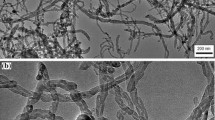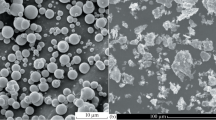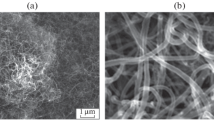Abstract
The additives improve the properties of magnetorheological elastomer by modifying the surface of ferromagnetic filler particles or by varying the properties of a host polymer matrix. In this study, effect of carbon nanotube additive on the viscoelastic properties of magnetorheological elastomer reinforced with optimum quantity of ferromagnetic filler is studied. Room temperature vulcanizing silicone elastomer-based test samples are prepared by mixing the elastomer with the carbon nanotube and carbonyl iron powder blend obtained from ultrasonication. Viscoelastic properties are measured by adopting the dynamic blocked transfer stiffness method. The results revealed that the properties of magnetorheological elastomer vary significantly with the inclusion of carbon nanotube. With the addition of 0.5 wt% carbon nanotube, the zero field dynamic stiffness of magnetorheological elastomer is enhanced by 36.7% and the loss factor is increased by 17.2%. The enhancement in zero field properties led to the least field-induced enhancement for magnetorheological elastomer doped with 0.5 wt% carbon nanotube. A relatively larger flexibility of pure magnetorheological elastomer samples had resulted in the maximum field-induced enhancement of 48.04%. Among the prepared test samples with carbon nanotube addition, the sample loaded with 0.25 wt% carbon nanotube exhibited a pronounced stiffness enhancement and lower loss factor. This substantiated the existence of an optimum limit for carbon nanotube additive. The present study also confirmed the feasibility of developing MRE tailor-made to suit the particular application by selecting a proper composition of matrix, filler and the additives.







Similar content being viewed by others
References
Rivin EI (1995) Vibration isolation of precision equipment. Precis Eng 17(1):41–56
Ellison J, Ahmadi G, Kehoe M (2001) Passive vibration control of airborne equipment using a circular steel ring. J Sound Vib 246(1):1–28
Stelzer GJ, Schulz MJ, Kim J et al (2003) A magnetorheological semi-active isolator to reduce noise and vibration transmissibility in automobiles. J Intell Mater Syst Struct 14(12):743–765
Behrooz M, Sutrisno J, Zhang L et al (2015) Behavior of magnetorheological elastomers with coated particles. Smart Mater Struct 24(3):35026. https://doi.org/10.1088/0964-1726/24/3/035026
Jolly MR, Carlson JD, Muñoz BC (1999) A model of the behaviour of magnetorheological materials. Smart Mater Struct 5(5):607–614
Zając P, Kaleta J, Lewandowski D et al (2010) Isotropic magnetorheological elastomers with thermoplastic matrices: structure, damping properties and testing. Smart Mater Struct 19(4):45014
Lokander M, Stenberg B (2003) Performance of isotropic magnetorheological rubber materials. Polym Test 22(6):677–680
Chen L, Gong XL, Li WH (2008) Effect of carbon black on the mechanical performances of magnetorheological elastomers. Polym Test 27(3):340–345
Li R, Sun LZ (2011) Dynamic mechanical behavior of magnetorheological nanocomposites filled with carbon nanotubes. Appl Phys Lett 99(13):2012–2015
Malecki P, Krolewicz M, Krzak J et al (2015) Dynamic mechanical analysis of magnetorheological composites containing silica-coated carbonyl iron powder. J Intell Mater Syst Struct 26(14):1899–1905
Chen D, Yu M, Zhu M et al (2016) Carbonyl iron powder surface modification of magnetorheological elastomers for vibration absorbing application. Smart Mater Struct 25(11):115005
Yang J, Gong X, Deng H et al (2012) Investigation on the mechanism of damping behavior of magnetorheological elastomers. Smart Mater Struct 21:125015
Dong X, Ma N, Qi M et al (2012) The pressure-dependent MR effect of magnetorheological elastomers. Smart Mater Struct 21(7):75014
Wang Y, Hu Y, Chen L et al (2006) Effects of rubber/magnetic particle interactions on the performance of magnetorheological elastomers. Polym Test 25(2):262–267
Kaleta J, Królewicz M, Lewandowski D (2011) Magnetomechanical properties of anisotropic and isotropic magnetorheological composites with thermoplastic elastomer matrices. Smart Mater Struct 20(8):85006
Qiao X, Lu X, Li W et al (2012) Microstructure and magnetorheological properties of the thermoplastic magnetorheological elastomer composites containing modified carbonyl iron particles and poly(styrene-b-ethylene-ethylenepropylene-b-styrene) matrix. Smart Mater Struct 21(11):115028
Aishah S, Aziz A, Mazlan SA et al (2016) Effects of multiwall carbon nanotubes on viscoelastic properties of magnetorheological elastomers. Smart Mater Struct 25:77001
Ge L, Gong X, Fan Y, Xuan S (2013) Preparation and mechanical properties of the magnetorheological elastomer based on natural rubber/rosin glycerin hybrid matrix. Smart Mater Struct 22(11):115029
Rabindranath R, Böse H (2013) On the mobility of iron particles embedded in elastomeric silicone matrix. J Phys Conf Ser 412:12034
Gong XL, Zhang XZ, Zhang PQ (2005) Fabrication and characterization of isotropic magnetorheological elastomers. Polym Test 24(5):669–676
Wu J, Gong XL, Chen L et al (2009) Preparation and characterization of isotropic polyurethane magnetorheological elastomer through in situ polymerization. J Appl Polym Sci 114:901–910
Wang Y, Zhang X, Oh J et al (2015) Fabrication and properties of magnetorheological elastomers based on CR/ENR self-crosslinking blends. Smart Mater Struct 24(9):95006
Tian TF, Li WH, Alici G, Du H et al (2011) Microstructure and magnetorheology of graphite-based MR elastomers. Rheol Acta 50(9–10):825–836
Bica I, Anitas EM, Bunoiu M et al (2014) Hybrid magnetorheological elastomer: Influence of magnetic field and compression pressure on its electrical conductivity. J Ind Eng Chem 20(6):3994–3999
Yang J, Gong XL, Zong L et al (2013) Silicon carbide-strengthened magnetorheological elastomer: preparation and mechanical property. Polym Eng Sci 53:2615–2623
Zhang XX, Wen GH, Huang S et al (2001) Magnetic properties of Fe nanoparticles trapped at the tips of the aligned carbon nanotubes. J Magn Magn Mater 231:9–12
Zilli D, Chiliotte C, Escobar MM et al (2005) Magnetic properties of multi-walled carbon nanotube-epoxy composites. Polymer 46(16):6090–6095
Schadler LS, Brinson LC, Sawyer WG (2007) Polymer nanocomposites: a small part of the story. JOM 59(3):53–60
Davis LC (1999) Model of magnetorheological elastomers. J Appl Phys 85(6):3348–3351
Udupa G, Rao SS, Gangadharan KV (2015) Fabrication of functionally graded carbon nanotube-reinforced aluminium matrix laminate by mechanical powder metallurgy technique—part I. J Mater Sci Eng 4(3):1000169
BS I 108460-2 (2008) Acoustics and vibration—measurement of vibro-acoustic transfer properties of resilient elements—part 2: direct method for determination of the dynamic stiffness of resilient supports for translatory motion (ISO 10846-2:2008)
Brown RP (1996) Physical testing of rubber. Chapman and Hall, London
Lakes R (2009) Viscoelastic materials. Cambridge University Press, Cambridge
Poojary UR, Hegde S, Gangadharan KV (2016) Dynamic blocked transfer stiffness method of characterizing the magnetic field and frequency dependent dynamic viscoelastic properties of MRE. Korea-Aust Rheol J 28(4):301–313
Lion A, Kardelky C (2004) The Payne effect in finite viscoelasticity: constitutive modelling based on fractional derivatives and intrinsic time scales. Int J Plast 20(7):1313–1345
Poojary UR, Gangadharan KV (2017) Magnetic field and frequency dependent LVE limit characterization of magnetorheological elastomer. J Braz Soc Mech Sci Eng 39(4):1365–1373
Stacer RG, Hubner C, Husband DM (1990) Binder/filler interaction and the nonlinear behavior of highly-filled elastomers. Rubber Chem Technol 63:488–502
Osman MA, Atallah A (2006) Effect of the particle size on the viscoelastic properties of filled polyethylene. Polymer 47(7):2357–2368
Feng LJ, Gong XL (2008) Dynamic damping property of magnetorheological elastomer. J Cent South Univ Technol 15:261–265
Yu M, Qi S, Fu J et al (2017) Understanding the reinforcing behaviors of polyaniline-modified carbonyl iron particles in magnetorheological elastomer based on polyurethane/epoxy resin IPNs matrix. Compos Sci Technol 139:36–46
Liao G, Gong X, Xuan S, Guo C, Zong L (2012) Magnetic-field-induced normal force of magnetorheological elastomer under compression status. Ind Eng Chem Res 51(8):3322–3328
Chen L, Jerrams S (2011) A rheological model of the dynamic behavior of magnetorheological elastomers. J Appl Phys 110:013513–6
Ju BX, Yu M, Fu J et al (2012) A novel porous magnetorheological elastomer: preparation and evaluation. Smart Mater Struct 21:35001
Chen L, Gong XL (2008) Damping of magnetorheological elastomers. Chin J Chem Phys 21(6):581–585
Zhu J, Xu Z, Guo Y (2013) Experimental and modeling study on magnetorheological elastomers with different matrices. J Mater Civ Eng 25(11):1762–1771
Chen Y, Xu C (2011) Specific nonlinear viscoelasticity behaviors of natural rubber and zinc dimethacrylate composites due to multi-crosslinking bond interaction by using rubber process analyzer 2000. Polym Compos 32:1593–1600
Ginic M et al (2000) Viscoelastic behaviour of filled, and unfilled, EPDM elastomer. Thermochim Acta 357:211–216
Funt JM (1988) Dynamic testing and reinforcement of rubber. Rubber Chem Technol 61:842–865
Li WH, Zhou Y, Tian TF (2010) Viscoelastic properties of MR elastomers under harmonic loading. Rheol Acta 49:733–740
Gong XL, Xu Y, Xuan S, Guo C, Zong L (2012) The investigation on the nonlinearity of plasticine-like magnetorheological material under oscillatory shear rheometry. J Rheol 56(6):1375–1391
Jong L (2005) Viscoelastic properties of Ionic polymer composites reinforced by Soy protein isolate. J Polym Sci B Polym Phys 43:3503–3733
Deshpande AP, Krishnan JM, Kumar S (2010) Rheology of complex fluids. Springer, Berlin
Fuente JL et al (2002) Viscoelastic behaviour in a Hydroxyl-Terminated Polybutadiene gum and its highly filled composites: effect of the type of filler on the relaxation process. J Appl Polym Sci 88:1705–1712
Leopoldes J et al (2002) Influence of filler-rubber interactions on the viscoelastic properties of carbon-black-filled rubber compounds. J Appl Polym Sci 91:577–588
Yurkeli K (2001) Structure dynamics of carbon black filled elastomer. J Polym Sci B Polym Phys 39:256–275
Li WH, Zhang XZ (2010) A study of the magnetorheological effect of bimodal particle based magnetorheological elastomers. Smart Mater Struct 19(3):35002–8
Acknowledgements
The authors acknowledge the funding support from SOLVE: The Virtual Lab @ NITK (Grant Number: No.F.16-35/2009-DL Ministry of Human Resources Development) and experimental facility provided by Centre for System Design (CSD) (csd.nitk.ac.in): A Centre of excellence at NITK-Surathkal.
Author information
Authors and Affiliations
Corresponding author
Rights and permissions
About this article
Cite this article
Poojary, U.R., Hegde, S. & Gangadharan, K.V. Experimental investigation on the effect of carbon nanotube additive on the field-induced viscoelastic properties of magnetorheological elastomer. J Mater Sci 53, 4229–4241 (2018). https://doi.org/10.1007/s10853-017-1883-y
Received:
Accepted:
Published:
Issue Date:
DOI: https://doi.org/10.1007/s10853-017-1883-y




